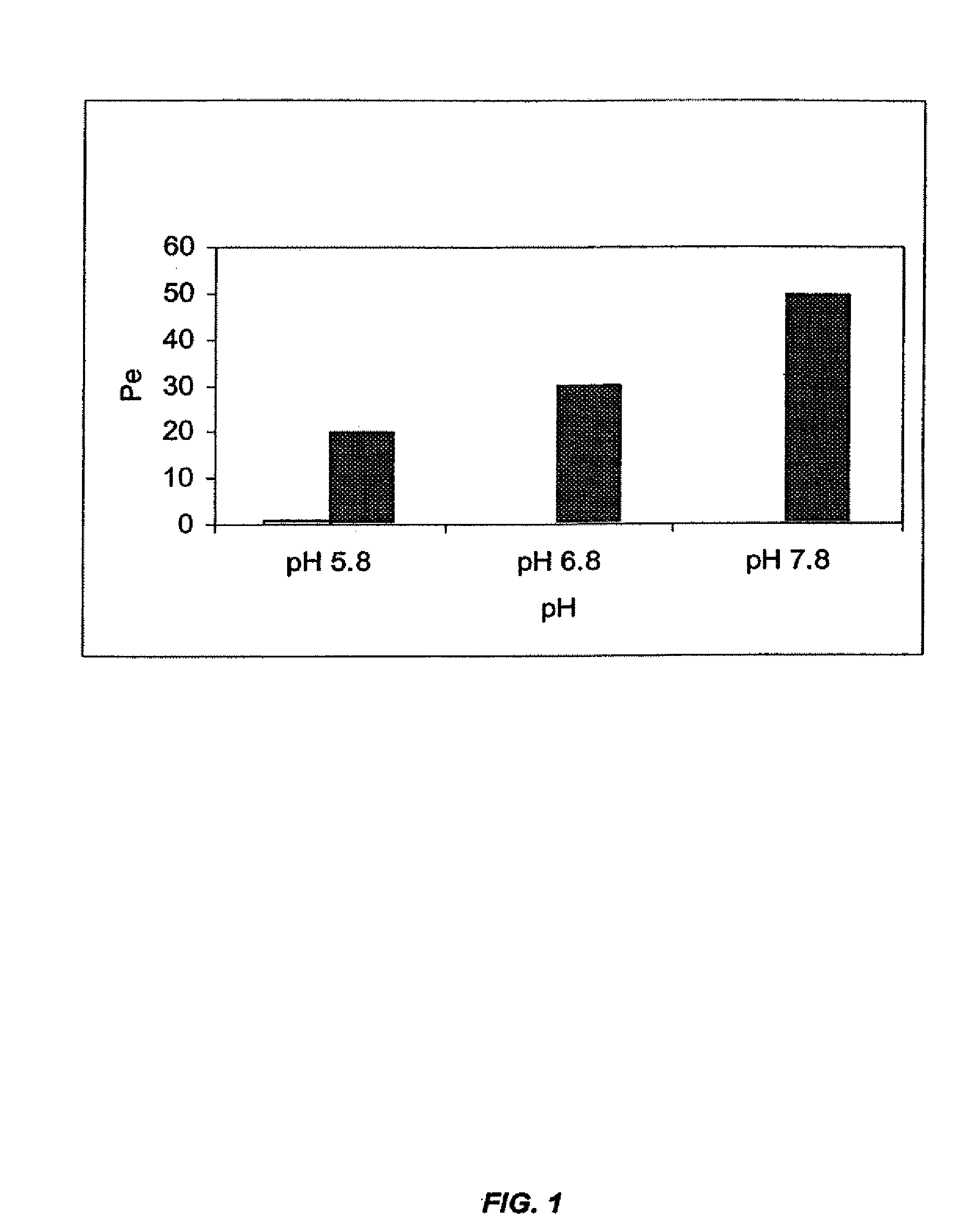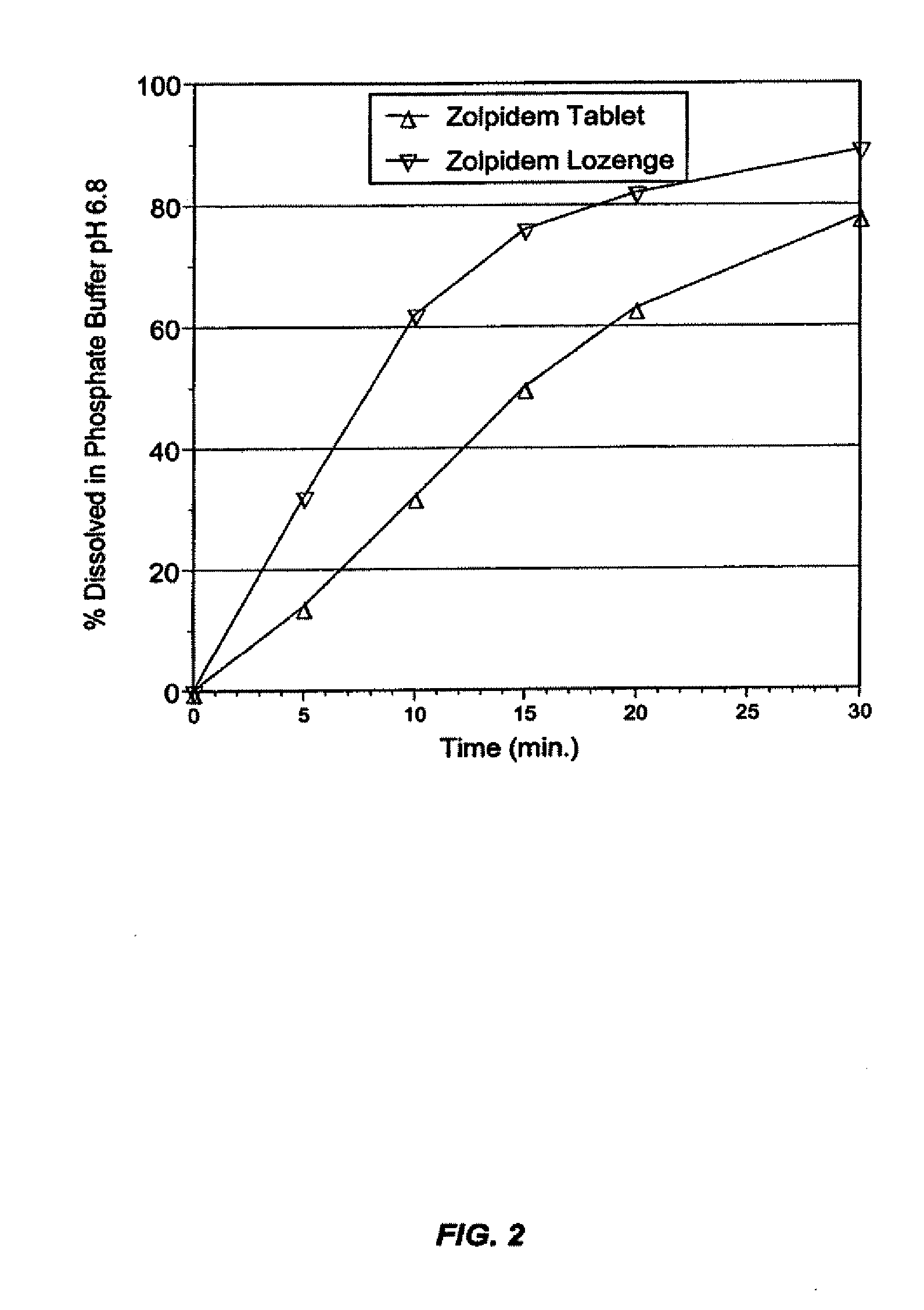Compositions for delivering hypnotic agents across the oral mucosa and methods of use thereof
a technology of hypnotic agents and compositions, applied in the field of compositions for delivering hypnotic agents across the oral mucosa, can solve the problems of benzodiazepines that interfere with memory, cognition and psychomotor function, hangover effects, and altered sleep architecture, and achieve low inter-subject variability, rapid and efficient absorbing, and lower variability
- Summary
- Abstract
- Description
- Claims
- Application Information
AI Technical Summary
Benefits of technology
Problems solved by technology
Method used
Image
Examples
example 1
[0217] This example illustrates the beneficial effects of pH adjustment on membrane penetration for a zolpidem dosage form.
[0218] The effect of pH adjustment on the extent of ionization, and hence, the extent to which a therapeutic agent will traverse the mucous membrane can be demonstrated using a membrane assay; see, e.g., Kansy et al., J. Med. Chem., 41:1007-1010 (1998); and Avdeef, Curr. Topics Med. Chem., 1:277-351 (2001). This assay uses a lipid-coated membrane to predict lipid mucosal membrane penetration. The membrane apparatus consists of a dodecane membrane sandwiched between a donor and acceptor cell. The lipid-coated membrane is less porous then the mucous membrane of the oral cavity. Thus, the enhancement seen in the membrane assay is very likely to be magnified in vivo.
[0219] Membrane assays were performed using zolpidem tartrate solutions at a pH of 5.8, 6.8, and 7.8. The alkaline pH values of 7.8 were adjusted using freshly prepared 0.01 M s...
example 2
Zolpidem Gum Compositions
[0220] This example illustrates the zolpidem chewing gum compositions of the present invention.
[0221] Zolpidem can be formulated as a chewing gum composition as described above. In these embodiments, the unit dose or serving of the chewing gum comprises from about 0.1 to about 100 milligrams (mg) zolpidem (as measured in its tartrate salt form), preferably from about 1 to about 50 mg, and more preferably from about 2 to about 25 mg. In other embodiments, the unit dose comprises from about 2 to about 20 mg zolpidem, preferably from about 5 to about 15 mg. Extra zolpidem, for example, up to from about 10% to about 25% by weight, can be added as “overage” or as the amount that may be expected to be “washed away” and not otherwise released or absorbed during mastication.
[0222] In another embodiment, the unit dose or serving of the chewing gum comprises from about 0.81 to about 42 mg zolpidem in its base form, and more preferably from about 1.64 to about 20.5 ...
example 3
Zolpidem Tablet Compositions
[0230] This example illustrates the slow-dissolving, quick-dissolving, and chewable zolpidem tablet compositions of the present invention.
[0231] Zolpidem can be formulated as a tablet composition as described above. In these embodiments, the unit dose or serving of the tablet comprises from about 0.1 to about 100 milligrams (mg) zolpidem (as measured in its tartrate salt form), preferably from about 1 to about 50 mg, and more preferably from about 2 to about 25 mg. In other embodiments, the unit dose comprises from about 2 to about 20 mg zolpidem, preferably from about 2 to about 15 mg, and more preferably from about 2 to about 10 mg, e.g., about 2, 3, 4, 5, 6, 7, 8, 9, or 10 mg. In particularly preferred embodiments, the unit dose comprises a dose of zolpidem that is less than the dose typically used in commercial oral tablets, but possesses comparable or greater bioavailability and onset of therapeutic activity as well as lower variability of drug abs...
PUM
| Property | Measurement | Unit |
|---|---|---|
| concentration | aaaaa | aaaaa |
| particle size | aaaaa | aaaaa |
| particle size | aaaaa | aaaaa |
Abstract
Description
Claims
Application Information
 Login to View More
Login to View More - R&D
- Intellectual Property
- Life Sciences
- Materials
- Tech Scout
- Unparalleled Data Quality
- Higher Quality Content
- 60% Fewer Hallucinations
Browse by: Latest US Patents, China's latest patents, Technical Efficacy Thesaurus, Application Domain, Technology Topic, Popular Technical Reports.
© 2025 PatSnap. All rights reserved.Legal|Privacy policy|Modern Slavery Act Transparency Statement|Sitemap|About US| Contact US: help@patsnap.com



